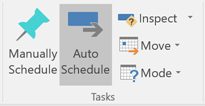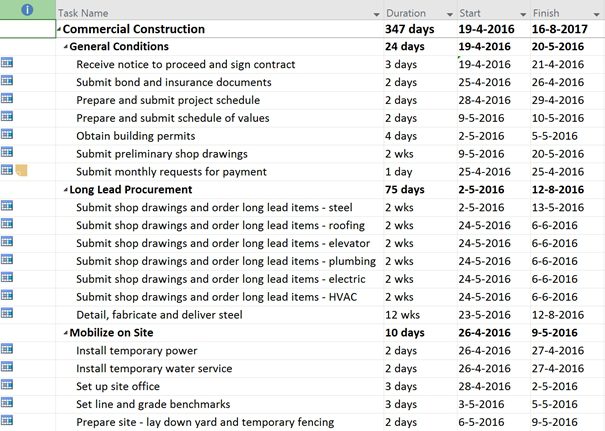Want to continue creating great Microsoft Project Schedules? Last time I shared three best practice “DO’s” to follow on scheduling. This time I’ll share three things to avoid.
DON’T Use the Start and Finish Columns
Microsoft Project is a scheduling tool with a true passion for dynamic information. In other words, it works best when you link tasks together and don’t force actual dates.
In an earlier article, I wrote about flaws in the use of Project. The use of the start and finish columns is a major flaw. And I see this happening with both first-time and veteran users of the product.
The way to see if a project schedule uses the start and finish columns excessively is by the blue (or red) calendar icon in the indicator column:
If almost all tasks have these calendars, you’re surely using the columns that set a constraint on either the start or finish dates.
How do you fix this? Add the “type” and the “constraint date” columns to any Gantt view you have and either delete the constraint date value or change the type to “as soon as possible” or “as late as possible.”
DON’T Mistake Work for Duration
A common mistake derived from miscommunication is taking duration for work or vice versa. Consider this short conversation between a project manager and a team member:
PM: “How much time will you need to finish the design?”
TM: “I guess I’ll need three weeks.”
Now will the PM consider the reply as three weeks of duration? Or will the team member need 120 hours of work for the design?
The conversation shouldn’t end with this single question, but rather contain at least two follow-up questions:
PM: “Three weeks of work or will you be done after three weeks?”
TM: “Oh, the work will take me maybe 24 hours.”
PM: “So why will it take you three weeks to finish it? Can I help to speed that up?”
TM: “I have some other unfinished business, but if Dave can help me out, I’ll have the design finished by next week.”
Asking the right questions to get a complete view is essential to get a solid and correct schedule.
DON’T Use Manually Scheduled Tasks in Combination with Work
It’s time to get a bit more technical now. Microsoft introduced “manually-scheduled” tasks in the 2010 version of Project.

This new feature gave project managers the option to generate early sketch versions of any schedule. But it’s not intended for use in a schedule that’s on its way.
Dan Renier did an excellent video presentation where he describes everything you need to know about the manually-scheduled functionality. A key feature of his presentation at the Project 2014 Conference in Anaheim is that the manually scheduled task won’t be suitable for any task that has an assignment.
As he explains in the presentation, the automatically scheduled tasks will keep the task type you assigned to it intact whereas the manually-scheduled task will throw it out the window and keep a “fixed duration” task type even where this hasn’t been applied.
A Bonus! DON’T Forget Murphy
Change will happen in your schedule! Be prepared and keep these three aspects of a project manager at the top of your toolbox:
- Communicate;
- Document; and
- Evaluate
Communicate
Keep an open door policy with your team members and other stakeholders, but don’t wait for them to come to you with issues or requests. Get a formal structure of frequent meetings with stakeholders in the project.
Document
Documentation is a tedious job, but someone needs to formalize decisions, and there needs to be a clear and uniform understanding of the current situation the project is in. If you document every scope change, issue and risk in the schedule, you come prepared when Murphy knocks on your door. And you can send that jerk on his way as soon as possible.
Evaluate
Once your project is done, get the team back in a room and openly evaluate how the project went. Thank them for their commitment and tell them if the project was a financial success. But also ask them how the next project would be even better and ask them to evaluate you as their project manager. That will help ensure both your team and you grow.
_________________________________________________________________________________________________________________
Have a “DON’T” best practice of your own? Share it in the comments below!








Erik
Wow Phil, you are fast with a reply!
Thanks for commenting, and I do agree 100%. The goal of the article was having 3 Don’t to discuss. There are a number of other don’ts that can be mentioned. The ones you mention are high on that list 🙂
Thanks again for participating,
Erik
The Project Corner Blog
Jon Wagner
Erik,
Great post! That first rule is so hard to break. I do it every time but learned that constraints should be used like salt- very sparingly.
Erik
Hi Jon,
Thanks for participating, I do agree with your statement 🙂 “entering dates is like eating salt, don’t overdo it”. I just might quote you on this one in my next training course.
Erik
Erik
Marco, that’s another great advice. Keep assignments as simple as possible, they are already hard enough when managing 1 on 1 situations.
Kind regards,
Erik
Jigs Gaton
Great blog post! I teach MS Project, and those are all heavy hitters on the Don’t Do list. I’d add under “Document” that you can use the Notes feature to document line-by-line each and every task entry, and then print out the notes pages when sharing the schedule. Links to other relevant documents make your project a mini-database of project information plus data.
Erik
Hi Jigs,
Good to hear you agree with the don’ts :-). I think the Notes solution is a great “easy to use and low level” way too document information.
Thanks for Participating,
Erik van Hurck
TPC
Wayne Sadin
I don’t think the start/end and similar problems are unique to Project. I’ve used such tools going pack to the days of DOS, and I once picked CA-Superproject primarily because it started up in “task network” (PERT) view rather than in GANTT view.
I think a GANTT view is a great way to present information, especially using summary tasks/milestones, but all those lovely empty fields lead project managers to input things the critical path scheduler is supposed to do for you.
I always tell my PMs to start by diagramming the relationships between tasks (predecessors/successors) (and not to forget FS/SS/FF constraints)…then ‘lock’ TRULY fixed date events (e.g., the ship will sail when it sails, the election happens on a fixed date)…then to add resource names/availabilities (vacations, shifts, etc.) and task work hours…and THEN run a resource-leveling to determine a starting point for tuning/crashing/optimization.
Erik
Hi Bhawna,
I wrote a whole article on the subject on my own blog. Hope you enjoy: http://bit.ly/TPC_Backward
Kind regards,
Erik van Hurck